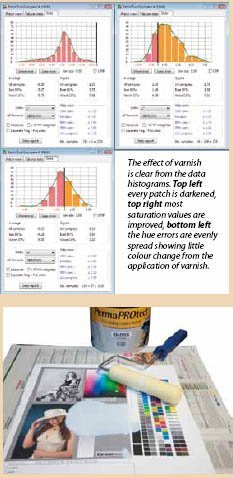articles/Paper/permajetmercury-page1
Permajet Jet Mercury Ultra White Matt Canvas - part 1 of 1 2 3
by Mike McNamee Published 01/12/2012

Mercury Ultra White Matt Canvas has a brightened coating, dropped onto a 405gsm Oxford Twill backing (ie a twinned warp with a thicker single weft in the canvas weave). As well as the new canvas, PermaJet also launched a new varnish at photokina and so this is tested alongside the canvas. The varnish is called PermaPROtect and is available in three finishes: gloss, satin and matt. They are aqueous varnishes, intended for brush and roller application (but roller is preferred).
We explored the use of both Epson Photo Black ink and the preferred Matt Black ink. These tests should have allowed us to measure the gamut volumes and the effect of the varnish on gamut volume. Unfortunately the i1 Pro spectro does not take kindly to measuring varnished targets from the profiler software and our efforts in this department were thwarted once again! We did get one gamut measurement that we were confident with and this indicated a gamut volume in the unvarnished state using PK ink as 612,407 which is a high value by any standard.
Testing
Testing was carried out using PermaJet's profile (from their website) along with an Epson 4900 using matt black ink. The audit target was measured before and after a single coat of varnish for all the relevant parameters.
Varnishing improved the statistics considerably (as was expected) and extremely pleasing data were obtained after a single coating of gloss.
Base White Measurements
The base coating is very bright (hence the 'ultra' tag) indeed it placed tenth in the database on both Fluorescence and Brightness readings. The varnish had a small influence on the whiteness parameters and did not kill off any brightness enhancement from the OBAs. This is desirable, there is no point in selecting a brightened media for the extra punch and then killing it with a UV rejecting varnish. The absence of any effect was detected both from the spectral data and also by examining the coated/uncoated material in the UV booth.
In summary then this is an ultra bright media and one of the brightest around, canvas or otherwise.

PermaPROtect Varnish
We tested the gloss variant which came in a 2.5l tin. The claimed coverage is about 40 square metres. Application was trivially simple. We dribbled three tablespoons of the wellstirred varnish into the middle of an A3 print and then gently pushed it about the surface using no downward pressure at all. We used the PermaJet High Density foam roller; do not be tempted to use anything else, the quality of the foam is important to prevent 'foaming' of the varnish. We started with a dry roller and so much of the 30ml of varnish was 'lost' into the roller. A second 30ml was enough to cover an A2 print with the pre-wet roller. The moral is obvious, if you coat one print at a sitting the usage will be higher than if you are coating numbers of prints. A single A3 would thus cost about 60p for varnish but this would fall perhaps to as low as 20p for more efficient use. This estimate is in accord with the PermaJet claim of 40m3 which would equate to about 17p for an A3.
Overall we liked the varnish a lot, very simple to use and it left us with a very pleasing gloss to the finished print (an attribute we understand many others have also commented favourably on).
The water-base made for very easy cleaning of the rollers afterwards and no unpleasant smells. We understand that PermaJet has concluded longevity testing of the varnish via an outside, UK laboratory and no degradation was measured after an equivalent of 85 years of exposure.
You are currently on page 1
- Permajet Jet Mercury Ultra White Matt Canvas page 1
- Permajet Jet Mercury Ultra White Matt Canvas page 2
- Permajet Jet Mercury Ultra White Matt Canvas page 3
1st Published 01/12/2012
last update 09/12/2022 14:57:34
More Paper Articles
There are 21 days to get ready for The Society of Photographers Convention and Trade Show at The Novotel London West, Hammersmith ...
which starts on Wednesday 14th January 2026





